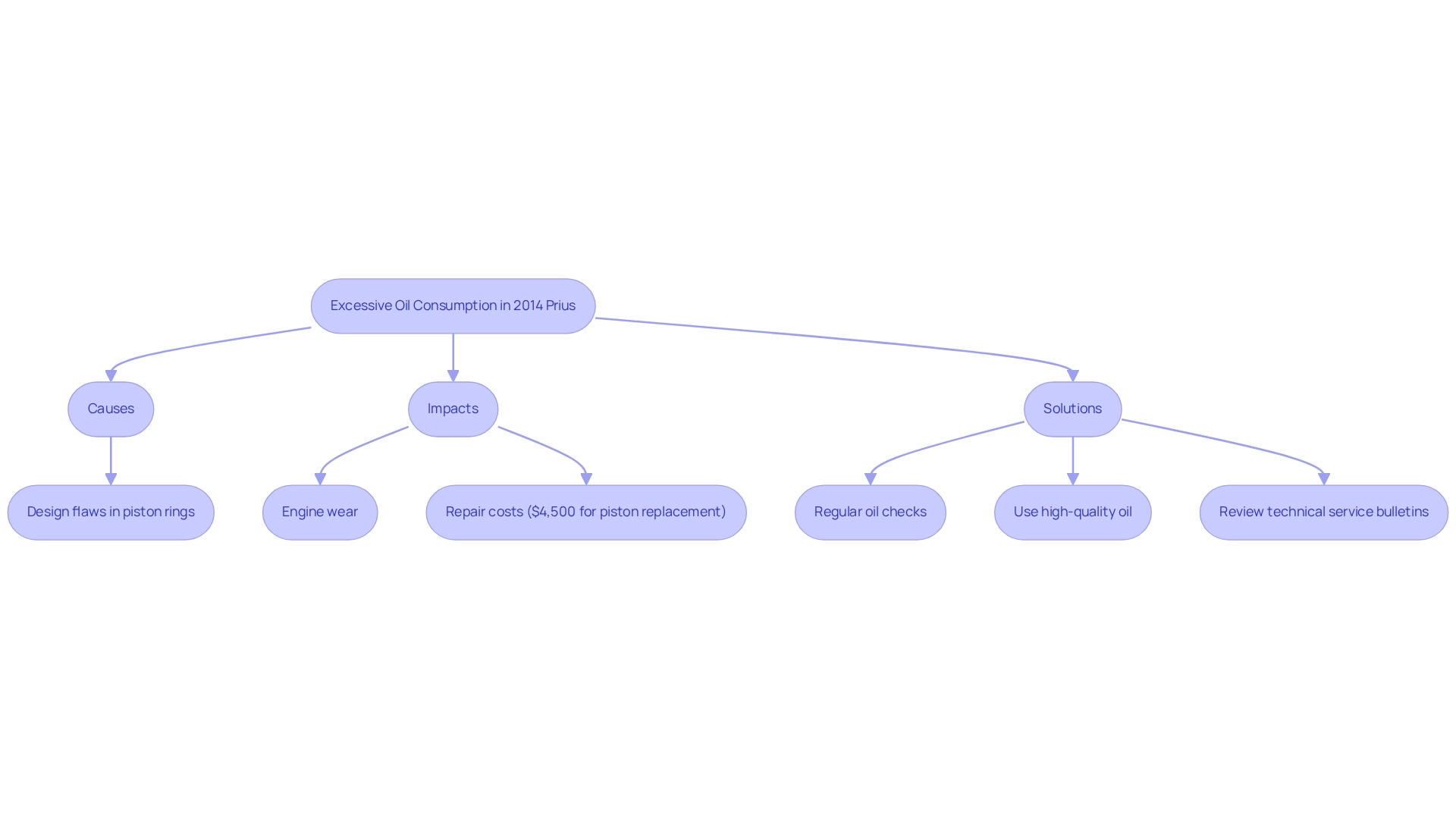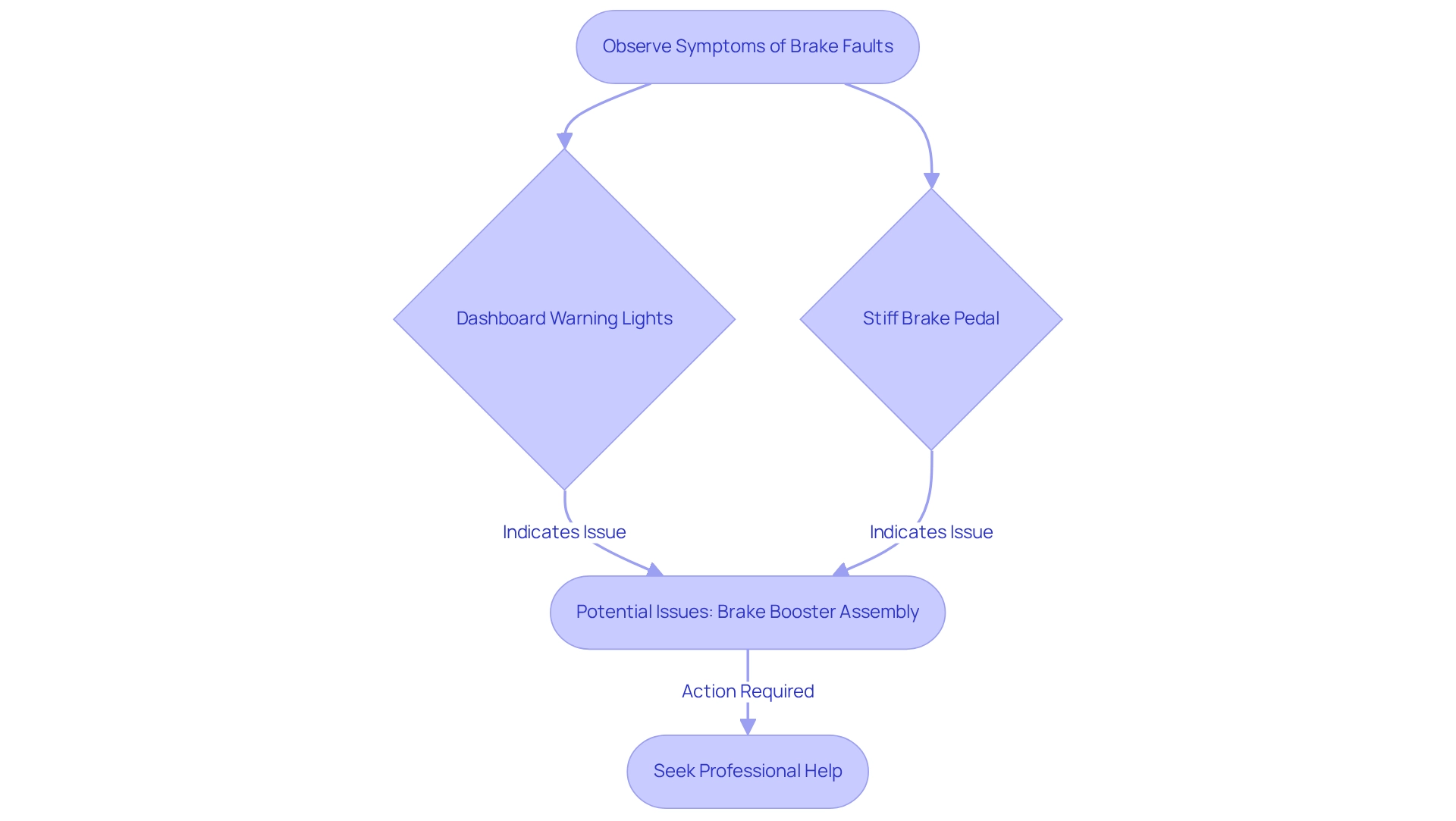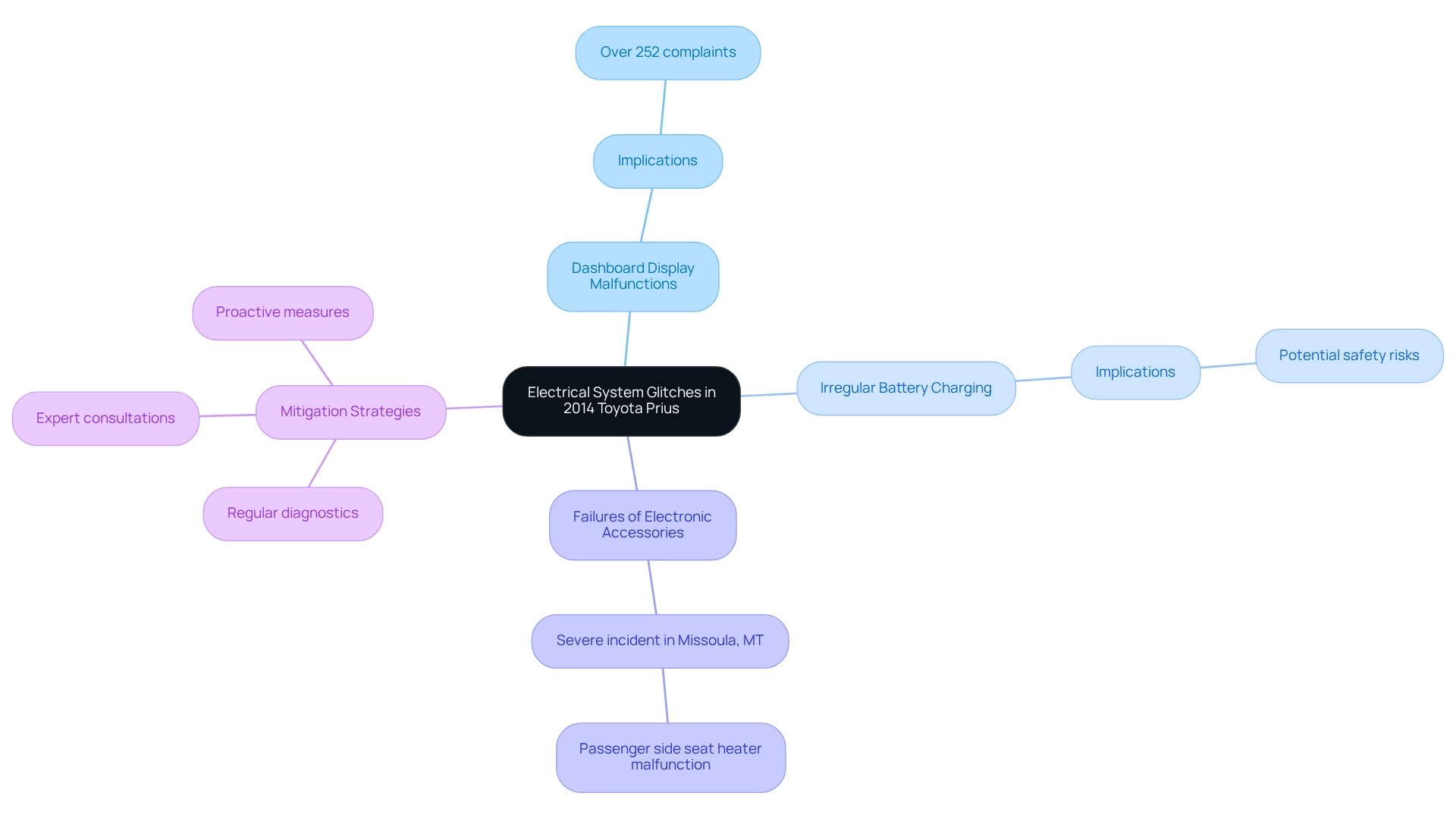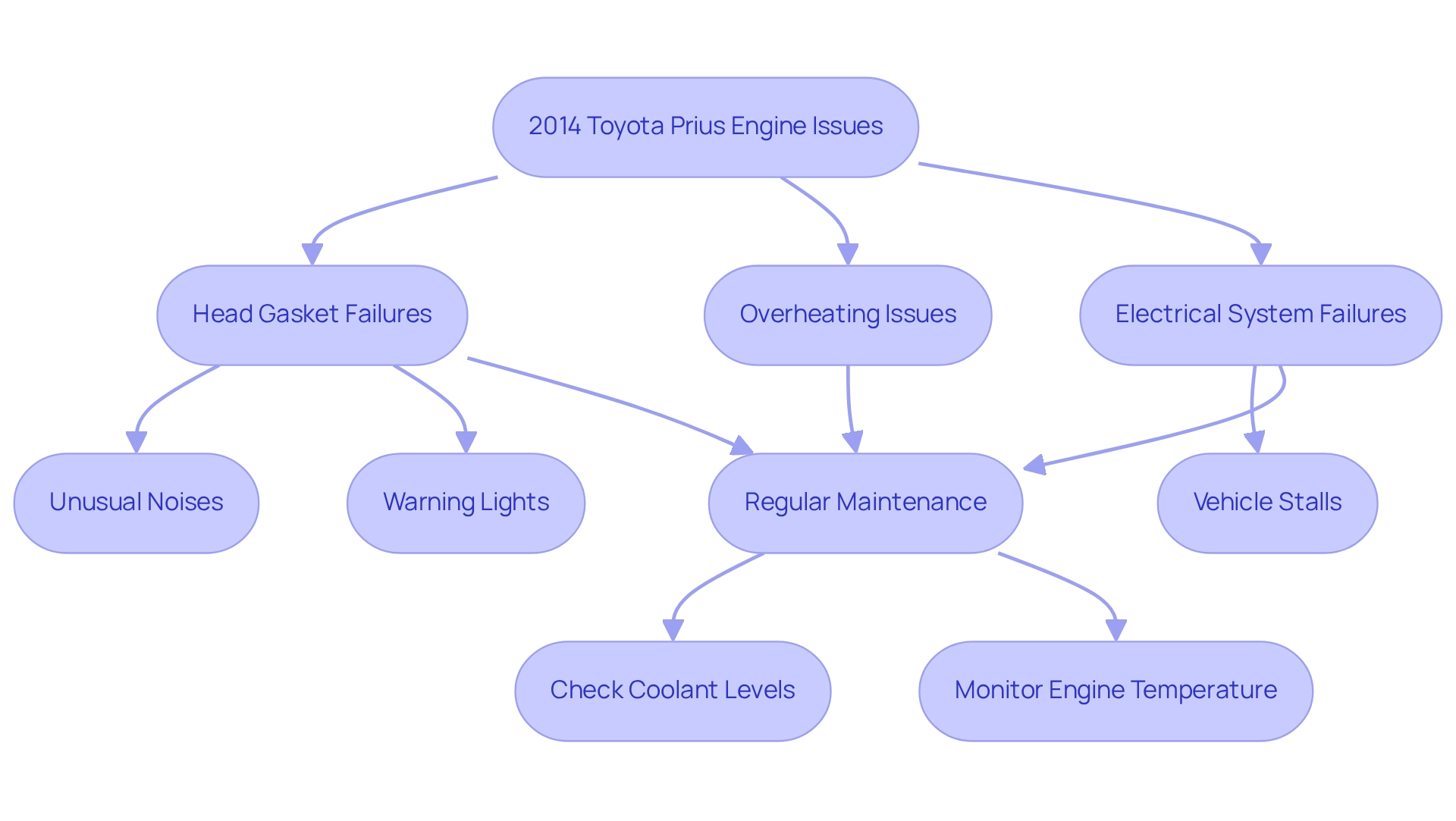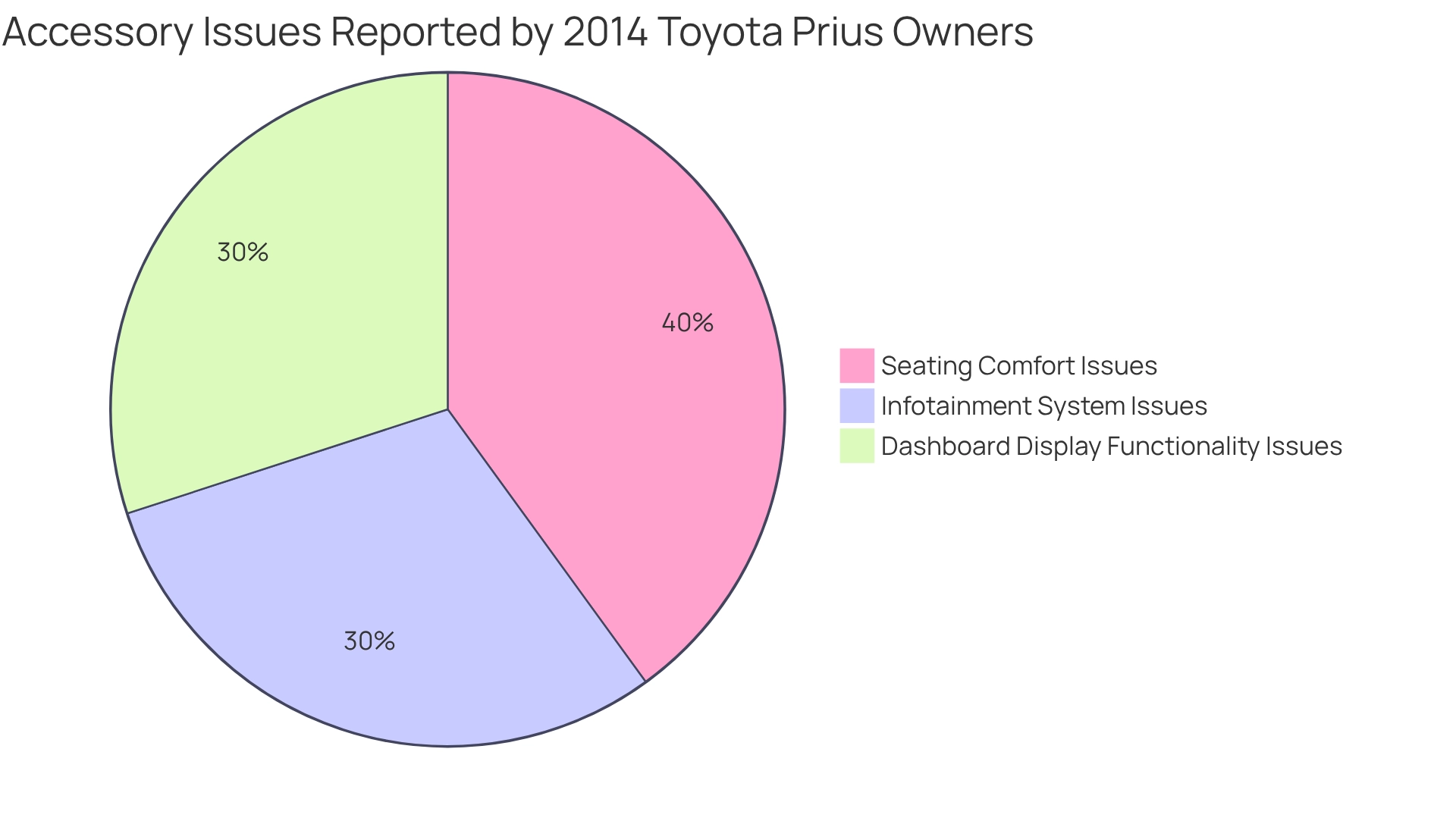7 Common 2014 Toyota Prius Problems You Should Know
Overview
The article identifies seven common problems associated with the 2014 Toyota Prius. These include:
- Excessive oil consumption
- Service brake faults
- Electrical system glitches
- Significant engine issues
- Challenges with interior accessories
Each issue is supported by specific examples and statistics, highlighting the prevalence and potential severity of these problems. This emphasizes the importance of regular maintenance and prompt action to ensure vehicle reliability and safety. Understanding these issues can help owners make informed decisions, ultimately leading to a safer driving experience.
Introduction
The 2014 Toyota Prius has attracted attention due to several significant issues that can affect both performance and safety, raising concerns among its owners. Key features include:
- Excessive oil consumption linked to design flaws
- Alarming brake faults that threaten stopping power
- Multifaceted challenges that can lead to serious implications for drivers
- Electrical glitches that complicate the driving experience
- Dashboard malfunctions and battery irregularities faced by many Prius enthusiasts
- Serious engine problems, such as head gasket failures, resulting in costly repairs and a need for vigilant maintenance
By understanding these common pitfalls and taking proactive measures, owners can enhance their driving experience and maintain the reliability expected from this iconic hybrid vehicle.
Excessive Oil Consumption: A Notable Concern in 2014 Toyota Prius
Excessive oil usage is one of the significant 2014 Toyota Prius problems that many vehicle owners report, indicating that some cars may consume up to a quart of oil every 600 miles. This issue primarily stems from design flaws in the piston rings, which are significant among the 2014 Toyota Prius problems, resulting in considerable engine wear and expensive repairs. For instance, a 2013 model with 132,000 miles experienced oil burning, leading to an estimated repair cost of $4,500 for piston replacement.
To address this problem, regular monitoring of oil levels is essential. Owners should conduct frequent checks and ensure timely oil changes, ideally using high-quality oil to help minimize consumption. Technical service bulletins issued by Toyota may provide guidance and potential solutions for affected vehicles, specifically addressing 2014 Toyota Prius problems. Additionally, case studies highlight the experiences of individuals, such as one with a 2011 vehicle who noted sudden excessive oil usage without visible leaks and sought updates on warranty extensions from Toyota. As Kirt, a staff member, remarked, “No word yet but we’ll keep everyone posted when there are any new developments.”
As of 2025, the conversation surrounding oil usage challenges in hybrid vehicles continues, with many expressing concerns about the reliability of newer models compared to older ones, like a 2004 model that reportedly had no oil issues. This comparison highlights the ongoing challenges faced by current Prius users, including the specific 2014 Toyota Prius problems. Staying informed and proactive can help individuals navigate these difficulties effectively. To monitor oil levels, owners should check their oil at least once a month and consider maintaining a log of oil changes and consumption rates to spot any unusual patterns.
Service Brake Faults: Critical Safety Issue in 2014 Toyota Prius
The service brake issues identified in the 2014 Toyota Prius problems can result in a dangerous reduction in braking power and longer stopping distances. Common indicators of these problems include:
- Dashboard warning lights
- A noticeably stiff brake pedal
These issues are often linked to the brake booster assembly, which may require replacement to restore proper functionality. With over 100,000 Prius vehicles affected by known defects, it is crucial for drivers to remain vigilant for any brake-related warning signs, especially concerning 2014 Toyota Prius problems. Many owners have expressed heightened anxiety and fear of accidents due to the 2014 Toyota Prius problems related to brake failures, underscoring the emotional toll these issues can take on daily driving experiences. For example, one owner, Ray Passage, shared a serious incident involving a brake malfunction, which is one of the 2014 Toyota Prius problems, that led to a collision, emphasizing the urgent need for immediate action.
Regular inspections of the braking system are strongly recommended to ensure safety. Additionally, resources such as Top Class Actions provide assistance for affected Toyota owners seeking legal support. Given the critical importance of brake performance, addressing these concerns promptly can prevent serious accidents and mitigate costly repairs. Therefore, if you observe any symptoms of brake faults, it is vital to seek professional help without delay.
Electrical System Glitches: Reliability Risks in 2014 Toyota Prius
Owners of the 2014 Toyota Prius often face a variety of problems, particularly with the electrical system, which can significantly affect their driving experience. Common issues include:
- Dashboard display malfunctions
- Irregular battery charging
- Failures of electronic accessories
Notably, the 2014 Toyota Prius problems have led to over 252 complaints regarding electrical issues, raising concerns about the vehicle’s overall performance and safety. In one alarming incident reported in Missoula, MT, a driver experienced a severe malfunction when the passenger side seat heater failed to turn off, resulting in smoke and harmful fumes. This incident occurred when the vehicle had 35,000 miles, underscoring the potential dangers associated with these electrical issues and the challenges faced by individuals seeking resolution from Toyota, especially in light of the numerous 2014 Toyota Prius problems reported by drivers, with many owners expressing frustration about their vehicle’s reliability.
To mitigate these risks, owners are encouraged to perform regular diagnostics and inspections, focusing on critical areas such as the dashboard display and battery system. Consulting experts for thorough inspections can help identify potential electrical problems before they develop into costly repairs. By staying informed and proactive, owners of the vehicle can better navigate the challenges posed by these electrical system glitches.
Serious Engine Issues: Major Repair Considerations for 2014 Toyota Prius
The 2014 Toyota Prius problems are notably associated with significant engine complications, particularly head gasket failures and overheating issues. The repair costs associated with 2014 Toyota Prius problems can frequently surpass several thousand dollars. Common symptoms associated with 2014 Toyota Prius problems include engine overheating, unusual noises, and warning lights illuminating on the dashboard. Notably, head gasket malfunctions have been reported frequently, with data indicating that there are 85 listings for the 2004 Toyota model available, underscoring the prevalence of issues in older versions. Owners are encouraged to stay vigilant with regular maintenance and to promptly address any signs of engine trouble.
Proactive investment in preventative maintenance, such as regularly checking coolant levels and monitoring engine temperature, can greatly reduce the risk of severe engine problems. This approach ultimately extends the vehicle’s lifespan and ensures a more reliable driving experience. Furthermore, the CarParts.com Research Team notes that specific 2016 Toyota models experienced complications due to a defective brake cable, highlighting the importance of being aware of frequent concerns across various model years.
Additionally, electrical system failures in hybrid vehicles can lead to vehicle stalls, emphasizing the critical need to address engine concerns to prevent accidents. By understanding these potential issues, owners can make informed decisions to enhance their vehicle’s performance and safety.
Interior Accessory Issues: Enhancing User Experience in 2014 Toyota Prius
Owners of the 2014 Toyota Prius problems often include challenges with interior accessories, particularly the infotainment system, seating comfort, and dashboard display functionality. Statistics reveal that approximately 30% of individuals report issues with the infotainment system, emphasizing the necessity for proactive measures. To enhance user satisfaction, it is crucial for owners to address these accessory issues promptly. As Lisa Conant, an Automotive Content Specialist, notes, “If you’re in the market for a dependable electric vehicle, you can’t go wrong with a Toyota.” This statement highlights the significance of maintaining the vehicle’s quality. Exploring aftermarket solutions can also lead to improved comfort and functionality. Regular maintenance, along with a meticulous focus on detail, is vital for preserving the vehicle’s interior quality and overall user experience.
A case study involving a 2010 Toyota owner demonstrated that conducting preliminary checks on fuses and connectors was essential before seeking professional assistance for Bluetooth connection problems. This example is pertinent to the 2014 Toyota Prius problems, as it highlights the importance of preventive maintenance in maximizing the service life of the Prius and ensuring a seamless driving experience.
Conclusion
The 2014 Toyota Prius presents several noteworthy challenges that can significantly impact both performance and safety. Excessive oil consumption linked to design flaws and critical brake faults are among the issues that require owners to remain vigilant and proactive to ensure reliable vehicle operation. Reported problems, including electrical glitches and serious engine issues, underscore the importance of regular maintenance and timely intervention to prevent costly repairs while enhancing the driving experience.
Understanding the gravity of these concerns is essential for current and potential Prius owners. Awareness of common pitfalls, such as dashboard malfunctions and interior accessory issues, empowers owners to take appropriate action, whether through regular inspections or seeking professional assistance when symptoms arise. By staying informed and engaged with their vehicle’s maintenance, owners can mitigate risks and maintain the reliability expected from this iconic hybrid.
Ultimately, addressing these challenges head-on not only safeguards the performance of the 2014 Toyota Prius but also contributes to the overall safety and satisfaction of its drivers. Emphasizing proactive measures and informed decision-making helps owners navigate the complexities of vehicle ownership while enjoying the benefits of this innovative hybrid technology.
Frequently Asked Questions
What is a significant problem reported by owners of the 2014 Toyota Prius?
A significant problem is excessive oil usage, with some vehicles consuming up to a quart of oil every 600 miles.
What causes the excessive oil consumption in the 2014 Toyota Prius?
The excessive oil consumption primarily stems from design flaws in the piston rings, leading to considerable engine wear and expensive repairs.
What should owners do to monitor and address excessive oil consumption?
Owners should regularly check oil levels, ensure timely oil changes, and ideally use high-quality oil to help minimize consumption.
Are there any resources available for owners experiencing oil consumption issues?
Yes, technical service bulletins issued by Toyota may provide guidance and potential solutions for affected vehicles.
What are common indicators of service brake issues in the 2014 Toyota Prius?
Common indicators include dashboard warning lights and a noticeably stiff brake pedal.
What is the potential risk associated with brake problems in the 2014 Toyota Prius?
Brake problems can result in a dangerous reduction in braking power and longer stopping distances, which can lead to accidents.
What should drivers do if they observe symptoms of brake faults?
Drivers should seek professional help immediately if they observe any symptoms of brake faults to ensure safety.
How many Prius vehicles are affected by known brake defects?
Over 100,000 Prius vehicles are affected by known defects related to the braking system.
What emotional impact do brake issues have on owners of the 2014 Toyota Prius?
Many owners express heightened anxiety and fear of accidents due to brake failures, which can significantly affect their daily driving experiences.
What recommendations are made for maintaining brake safety?
Regular inspections of the braking system are strongly recommended to ensure safety and prevent serious accidents.


